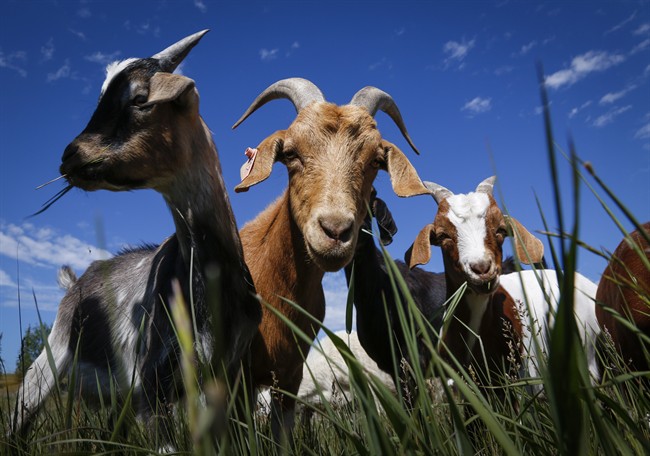Calgary park gets its goats: Animals part of pilot project to control weeds
Advertisement
Read this article for free:
or
Already have an account? Log in here »
To continue reading, please subscribe:
Monthly Digital Subscription
$0 for the first 4 weeks*
- Enjoy unlimited reading on winnipegfreepress.com
- Read the E-Edition, our digital replica newspaper
- Access News Break, our award-winning app
- Play interactive puzzles
*No charge for 4 weeks then price increases to the regular rate of $19.00 plus GST every four weeks. Offer available to new and qualified returning subscribers only. Cancel any time.
Monthly Digital Subscription
$4.75/week*
- Enjoy unlimited reading on winnipegfreepress.com
- Read the E-Edition, our digital replica newspaper
- Access News Break, our award-winning app
- Play interactive puzzles
*Billed as $19 plus GST every four weeks. Cancel any time.
To continue reading, please subscribe:
Add Free Press access to your Brandon Sun subscription for only an additional
$1 for the first 4 weeks*
*Your next subscription payment will increase by $1.00 and you will be charged $16.99 plus GST for four weeks. After four weeks, your payment will increase to $23.99 plus GST every four weeks.
Read unlimited articles for free today:
or
Already have an account? Log in here »
Hey there, time traveller!
This article was published 21/06/2016 (3423 days ago), so information in it may no longer be current.
CALGARY – They’re lean, mean, eating machines.
Calgary has introduced 106 goats to a city park in an experimental effort to wipe out noxious weeds — most notably the Canada thistle — in a more environmentally friendly way.
Three professional goatherds will monitor the animals 24 hours a day over the next three weeks. Trained herding dogs and horses will help keep the munchers in line.

“We’re interested in looking at ways that we can reduce the use of herbicides in our parks,” said Chris Manderson, who handles urban conservation for Calgary Parks. “We think this will be a really effective way to do it. Everything we know says it’s going to be as effective, if not more effective, than herbicide use.”
The 35-hectare area at Confluence Park in northeast Calgary is popular with cyclists, joggers and dog enthusiasts. The mostly natural landscape seems at odds with Deerfoot Trail — a major north-south corridor nearby.
But the constant buzz of traffic was ignored Tuesday as the multi-coloured herd got down to business in a non-stop feeding frenzy.
“We’re targeting the weed and we’re allowing natural plants to come in,” said Jeannette Hall, chief goatherd for the project.
“The benefit of goats over other livestock is that they actually destroy the seed in their droppings and they’re distributing a natural fertilizer which releases slowly — not like a chemical fertilizer which often ends up in our water systems.”
The Canada thistle is the biggest target, but the goats will be devouring up to 15 weeds in the park, Hall said.
“They can tackle cliffs, remote areas. They can work in heat. They can work right after the rain. Your limitations, your risk is lessened.”
Using goats for weed control isn’t new. It’s been around in Europe for centuries and closer to home was employed in Kamloops, B.C., and Regina to deal with invasive weeds.
Washington, D.C., has been bringing in goats to deal with kudzu, a plant native to East Asia, that can grow up to a foot a day. The plant is not poisonous to the goats.
Goats are a much more cost-effective weed-killing option. The Calgary goat project will cost $25,000. Applying herbicide to that much land would amount to $52,500.
Once the test period is over, the city will decide whether to expand the program to other parks.
“In managing our natural landscape, like the prairie here in Confluence Park, is the fact they did evolve under grazing pressure — if you think about bison on the landscape and cattle,” said Manderson.
“We fully expect grazing to be effective to control weeds. Right now, we’re just focused on seeing how well this works. Then we’ll revisit it and see if this becomes a tool we can use.”
— Follow @BillGraveland on Twitter


